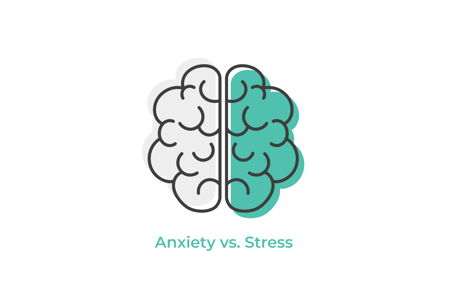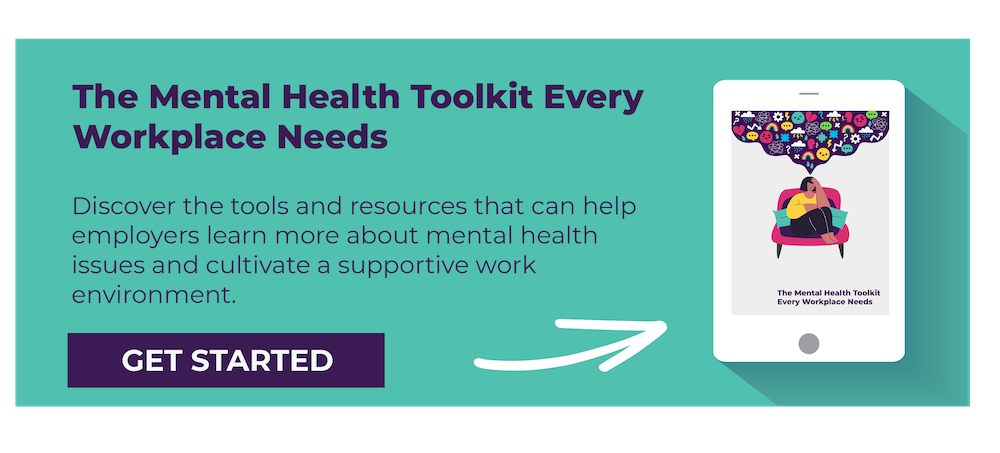 With the holidays and 2020 approaching fast, you may be noticing a nervous buzz in your office.
With the holidays and 2020 approaching fast, you may be noticing a nervous buzz in your office.
While this time of year can be joyous, it may also provoke a lot of stress and anxiety for your employees. End-of-year projects, financial stressors, family visits, and increased workloads may be impacting even your best workers.
But how do you know who is stressed and who is on the verge of a panic attack?
And as an employer, you may wonder if there’s a difference and how each impacts the workplace. Each year, anxiety, in particular, costs the global economy $1 trillion annually in lost productivity. Chronic stress, on the other hand, can manifest itself in a variety of physical and emotional health problems.
Both are bad news, but both are also treatable and manageable.
Read on for a deeper understanding of the differences between anxiety vs. stress.
The Difference Between Anxiety vs. Stress
Even though stress and anxiety may be words used interchangeably at times, they’re actually very different. Stress is a reaction to a stimulus; anxiety is a mental health condition that can be triggered by stress.
Keeping a supportive work environment can alleviate the side effects of both. Below we dive into the differences between each one and how it impacts employee and workplace health.
What is Stress?
At some point or another, we’ve all dealt with stress. Being late to an important meeting, traffic jams, pressing deadlines, etc. all can raise stress levels. As defined, stress is “a state of mental or emotional strain or tension resulting from adverse or very demanding circumstances.” Constant high levels of stress can wear on the strongest of people both physically and mentally.
Symptoms of Stress
- Muscle tension
- Irritability
- Increased heart rate
- Rapid breathing
- Forgetfulness
- Trembling
- Insomnia
- Headaches
- Stomach issues
Causes
Stress can be caused by anything from the pressure to get somewhere on time to taking a test. The body’s response to stress can be physical or emotional. Work, parenting, relationships, caregiving, etc. are all potential sources of stress. Usually, it can be pinpointed quickly as an issue that’s causing immediate inner turmoil.
Effects
Short-term stress can be beneficial in that it makes you focus on progress. For example, it may make you study for a test, schedule your projects, arrive on time, etc. It’s the ongoing stress that presents health concerns. Long-term stress can negatively impact emotional and physical health.
Chronic stress can cause:
- Obesity
- Heart issues
- High blood pressure
- Menstrual problems
- Mental health issues like anxiety, depression
- Gastrointestinal problems such as GERD
Treatment
Luckily, self-care can help with minimizing daily stress. Campaigns created by your wellness committees can focus on topics that encourage employees to focus on stress reduction.
Some ways to alleviate stress:
- Exercise
- Meditation
- Journaling
- Mindfulness
- Breathing exercises
What is Anxiety?
Anxiety can feel gripping for those who experience it. It’s defined as “a nervous disorder characterized by a state of excessive uneasiness and apprehension, typically with compulsive behavior or panic attacks.” Like stress, it has regular side effects, but it often lasts much longer — like recurring intrusive thoughts or concerns. These thoughts may cause someone with anxiety to avoid certain situations out of extreme worry.
Symptoms of Anxiety
- Sweating
- Muscle tension
- Irritability
- Rapid heart rate
- Forgetfulness
- Trembling
- Insomnia
- Headaches
- Stomach issues
- Rapid breathing
- Excessive feelings of worry
Causes
Anxiety may be precursored by stress, but that isn’t always the case. It can be caused by a physical condition, a mental condition, the effects of drugs, or a combo of all three. It may not be related to a specific event but is characterized by overall feelings of unease.
Effects
People with anxiety disorders may have trouble completing day-to-day tasks and functioning well in society. Untreated anxiety can lead to similar health problems as long-term stress such as heart problems and high blood pressure. It can also make it harder to learn and retain information.
Untreated anxiety can cause:
- PTSD
- Panic attacks
- OCD symptoms
- Total social isolation
- Loneliness or self-loathing
- Drug abuse or addiction
- Suicidal thoughts or behaviors
Treatment
Anxiety disorders are the most common mental health disorder in the U.S., impacting 18.1% of the population every year, according to the Anxiety and Depression Association of America. This disorder is highly-treatable, which can be hopeful news to those who suffer from it.
Anxiety treatment options include:
- Counseling - Talk therapy can help patients identify + process anxiety triggers
- Medication - Antidepressants can reduce anxiety symptoms
- Behavior modification - Changes to diet, exercise, sleep practices, etc. can help
- Self-care changes - Taking time away from stress and triggers can alleviate anxiety levels rising or anxiety attacks from happening. Meditation, spending time with friends, doing yoga, getting a massage, etc. are all examples of self-care.
Why The Difference Matters to Employers
Starting conversations about anxiety vs. stress can minimize the stigma surrounding mental conditions like anxiety. It should be just as easy to discuss anxiety as it is for employees to say, “I’m stressed.”
There are potential work-related risk factors when it comes to mental health, too, which is why it’s important for employers to know the difference between anxiety and stress. Setting proper policies and offering appropriate support can minimize risks.
Tips to Help Employees Dealing With Anxiety Disorders
There are plenty of ways to be supportive when it comes to helping employees with anxiety disorders. As a company, it’s a wise move for leadership to ensure employees are healthy both physically and mentally.
Here are a few tips on handling mental health issues like anxiety in the workplace with grace and tact:
- Welcome the discussion - Don’t let mental health be an “awkward” office conversation. Openly discuss personal experience and topics like anxiety as this CEO recently did.
- Implement and enforce policies - Leadership can work together to create policies and practices to help managers identify harmful or irrational behaviors due to mental illness. Offering relevant resources can minimize the impact the disorder has on workflow and the employee’s life.
- Be flexible - Sometimes people with anxiety need a day or two to regroup after an exhausting panic attack. Building in flexible work schedules, time off, and remote work can alleviate stress and anxiety for workers.
- Offer resources - Offer a bountiful amount of mental health resources. The Crisis Text Line and NAMI offer studies, statistics, and support for those with anxiety and other mental health issues.
- Keep it confidential - If an employee seeks you out, it’s likely under the impression that you will keep their conditions and concerns quiet. Let them know from the start that their conversation with you is confidential. Share with HR or the appropriate department if harmful behavior to self or others is discussed.
Learn more about mental health in the workplace on the World Health Organization (WHO) site.
Educate Yourself and Employees About Anxiety vs. Stress
Education is key to preventing and treating the negative side effects of stress and understanding when symptoms are pointing to anxiety disorders.
You don’t know what you don’t know. Some employees may think their crippling anxiety is actually terrible stress they can’t manage.
By providing resources and hosting open discussions, it creates educational opportunities and experiences for the entire company.
Use your wellness program as a way to support employees with stress-reduction techniques and encourage them to get help for anxiety. Whether it’s providing resources, onsite counselors, or just a listening ear, your employees dealing with either health concern will likely appreciate the support provided.
By educating yourself and your staff about the difference between stress and anxiety, it shows employees that mental wellness is important, too.
Ready to help your employees focus on their overall wellness? Check out The Employee Wellness Project, a detailed handbook to help employees discover optimum wellness.



